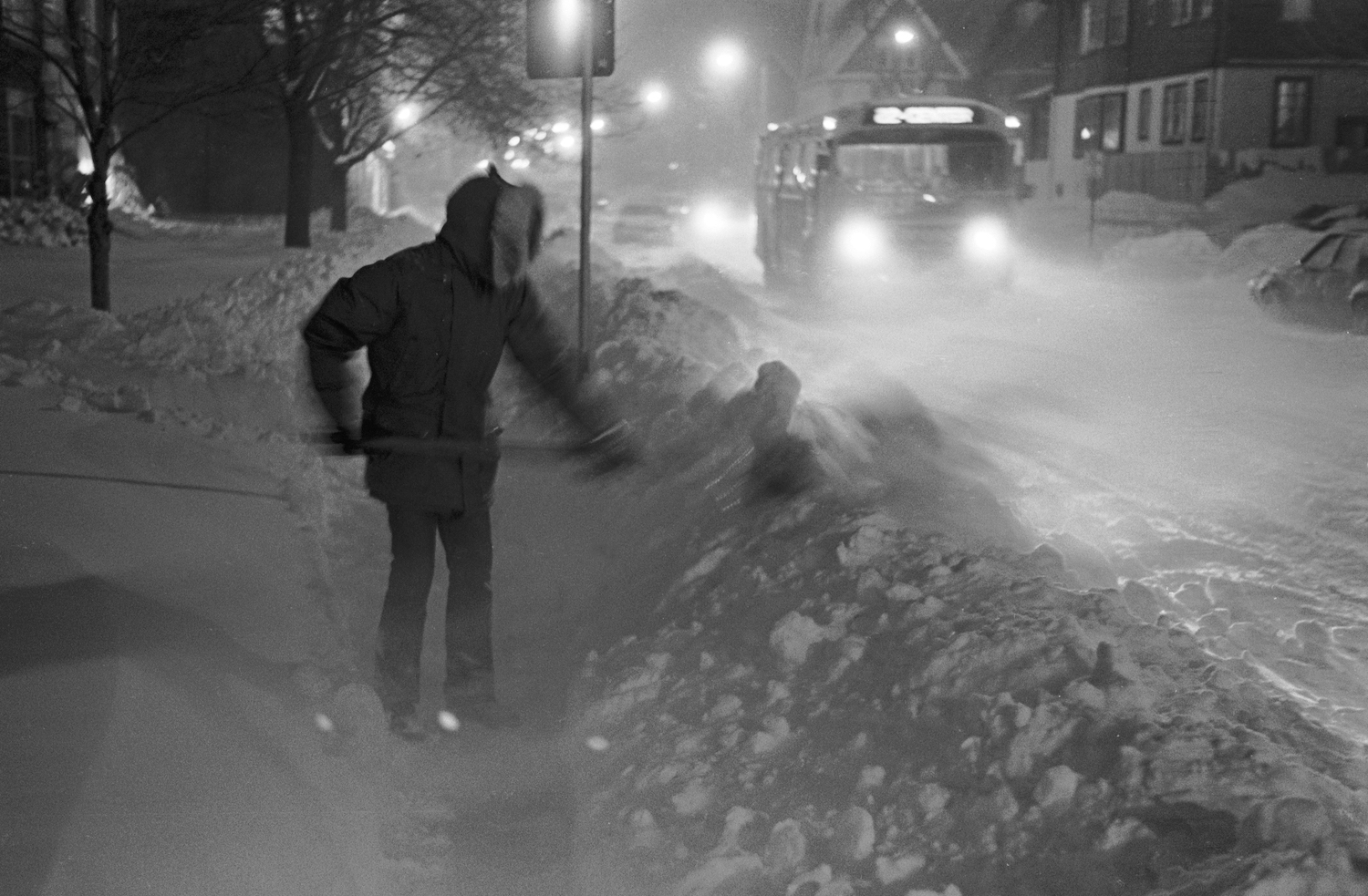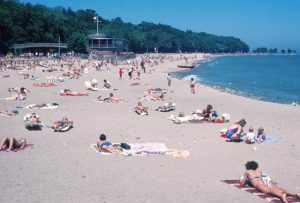Milwaukeeans love to boast about their weather almost as much as they love to complain about it. I’m reminded of an old song by John Martyn, “Bless the Weather.” It’s a love song of lament—the refrain noting that what the weather giveth, the weather taketh away: “Bless the weather that brought you to me//Curse the storm that takes you away.”[1] For Milwaukeeans, the beloved and the cursed IS the weather.
We take great pride in our extremes, filling up our social media with screenshots of brutal temperature recordings on our weather apps and pictures of cars buried in snow drifts. Floodwaters so high people post YouTube videos of wading chest-deep down Oakland Avenue. Blizzards that take days to dig out from and that everyone talks about for years afterwards. Heat waves that kill people. Hail the size of baseballs. Derecho winds and tornadoes recorded over 110 miles an hour, knocking down trees and powerlines, casting whole neighborhoods into darkness.
Certainly the weather extremes are what we remember, what we talk about in Milwaukee. When people move away, they usually cite the cold and the (to them) unending winter. New arrivals, particularly from southern or western climes, are astounded by the wardrobes they must acquire to get through the winter—flannel, down, wool, sweaters and fleeces and overcoats, gloves, scarves, hats, boots, and the endless layering that must go on before you set foot outside. Jokes are told: “There are only two seasons in Milwaukee—winter and road construction” (or its variation, “winter and a period of decidedly poor sledding”). Given the Plains to the west, there is nothing, it would seem, during the winter to stop the wind and the cold fronts they bear from the mountains of Colorado or from Canada (those famed “Alberta Clippers”) that ram snow, wind, and cold through Milwaukee with eye-watering force.
Die-hard Milwaukeeans will offer up that such weather “builds character,” and chortle at those stunned by winter’s casual brutality, but we’re also fiercely defensive of our everyday weather as well. I don’t know how often I’ve been told by people who call one coast or another home (and who’ve never been in the Midwest except to change planes in Chicago) that it must be hard living in a place where evidently the sun never shines, where it is grey all the time, as though the weather itself was in cahoots with our bleak, fly-over lives. In the Kevin Smith film Dogma, two angels kicked out of heaven are condemned to Milwaukee. They hang out at the airport. Over their shoulders, it is nothing but grey out the windows. Just to remind us this is Milwaukee (the scene was actually filmed in Pittsburgh), someone is selling cheeseheads in the background, his stall labeled “Cheesehead Country.” The camera pans past the lower part of a poster as the angels Loki (Matt Damon) and Bartleby (Ben Affleck) walk past it.[2] The poster reads, “Wisconsin Winter Magic.” And then one of the angels concocts a plan to get them out of their particular hell, which is Milwaukee.
Milwaukeeans know this. And so our Facebook feeds are filled with photos featuring gorgeous sunsets and armadas of cumulus clouds stacked and drifting across cerulean skies. “See? See? We have nice weather here, too!”
We take pride as well (good Midwesterners that we are), in Lake Michigan’s moderating effect on the weather. So much so that “Lake Effect” is used as a name for both a smooth jazz musical group and a punk band (one of the latter’s songs is “Great Lakes Powerviolence,”[3] which sounds just like what it seems—no, you don’t need to listen to it). “Lake Effect” is also the name for the Milwaukee arts and culture show produced by WUWM, Milwaukee’s NPR station.[4]
This so-called “lake effect” helps ameliorate both the hottest temperatures in summer and the colder temperatures in winter—at least for those living within about a mile or mile and a half of the lake (the effect dissipates as you go west). Milwaukee grew fastest around its lakefront, and some of its most expensive homes—in the years before central air and heating—were built along the lake. They were taking advantage not only of the water source but of the lake’s naturally moderating effect, first written about by our weather’s earliest chronicler, Increase Lapham (about which more later).[5] Lake Michigan is both colder than the nearby landmass of Milwaukee during the summer and warmer than the landmass in the winter. The airmass over the lake is thus cooler or warmer than the adjacent landmass, and lake breezes bring those airmasses onshore—and we go, “Ahhh!” and proclaim happily that it’s “Cooler near the lake.” That’s another phrase we love to utter. You can’t hear a weather report during the summer months without a meteorologist uttering it, and you can even wear it on your chest via T-shirts that feature a drawing of a red and white picnic cooler and a drawing of Lake Michigan (cooler by the lake—get it?).[6]
But that lake effect also brings lake effect snow as well—colder air moves over the warmer surface of the lake and picks up water vapor, which rises into the colder air above, then freezes and gets redeposited on the city, sometimes adding several extra inches onto snowstorms, or even giving the lakefront snow when inland there isn’t any.
No doubt this contributes to Milwaukeeans having a deeply ambivalent, even philosophical relationship with our weather, leavened with a certain amount of humor. Comme ci, comme ça. “Don’t like the weather? Wait five minutes, it’ll change,” Milwaukeeans say, which might explain why we huddle in front of our televisions and our smart phones, checking the weather somewhat incessantly.
We are aided in our mania by the local television stations, which offer “storm teams” and “first alerts” and “interactive radar” and “ready weather” and “weather plus” and compete with each other for who offers the forecast soonest, usually splitting their coverage into “first forecast” at the top of the news show, and then offering a longer weather segment just before sports, with a final “toss” back to the station’s meteorologist for a pithy “what tomorrow will be like” bit to close their coverage.
We have historical precedence for this focus on weather. Even before Wisconsin became a state, Increase Lapham began recording weather data at his home (on what is now West McKinley Avenue and 3rd Street, near the Milwaukee River), starting in 1837.[7] Lapham was named Milwaukee’s first observer for the Smithsonian Institution, which was the initial data collection agency for the Department of Agriculture.[8] The job was then handed to the Department of the Army, because weather and climate data was collected via the Signal Service.[9] Lapham not only collected his own data, he collated the data from other observers, forwarding that along, too. By November 1870, Lapham was including “probabilities” along with his data—essentially our nation’s first weather forecasts.[10] Lapham was also the person who first noticed, recorded, and produced a map of our fabled “lake effect.”[11]
It’s safe to say our National Weather Service was the brainchild of Lapham, one of Milwaukee’s most weather-obsessed citizens. Noting the number of ships on the Great Lakes lost or imperiled by not knowing what was coming, Lapham also lobbied hard (for over thirty years!) for a national storm warning system.
The Civil War put that push on hiatus, but after the war—and after a disastrous storm that swept the Great Lakes in November of 1869, in which “some ninety-seven vessels had been wrecked, thirty-five of them total losses, precious cargo was lost, and scores of sailors drowned,”[12] President Grant signed a resolution in 1870 that the Secretary of War “provide for taking meteorological observations at the military stations in the interior of the continent and at other points in the States and Territories…and for giving notice on the northern [Great] lakes and on the seacoast by magnetic telegraph and marine signals, of the approach and force of storms.”[13]
Lapham’s legacy also greatly benefited Milwaukee’s commercial life. A city where shipping traffic via water came to a dead halt once the harbor froze over was one thing. But frost and freezes also affected goods shipped by rail and cart and truck. By 1895 the Weather Service was issuing “cold wave signals”—notices for when it would be too cold to ship beer (and fruits and vegetables, those other staples of life, of course). Brewers and produce wholesalers timed their shipments based on these signals. Signals were also installed in the harbor at the mouth of the river so traffic heading out would know the wind direction, aiding navigation.[14] For a city so dependent on water transport for shipping and fishing and pleasure craft, knowing the weather has been invaluable.
Eventually the duties of collecting weather data and maintaining that storm warning system were transferred to the Department of Agriculture, which established the Weather Bureau (in 1891), and then to the Department of Commerce, which is when the Weather Bureau became the U.S. National Weather Service, which is now run by the National Oceanic and Atmospheric Administration within the Commerce Department.[15]
That move of the Weather Bureau from the Department of Agriculture to the Department of Commerce in 1940 also signals the country’s shift from an agrarian-based economy to a manufacturing- and commercial-based one—not surprising given we were on the eve of the Second World War. Nineteen forty was also when the city’s official collection point for weather data was shifted from its downtown location to what was then called General Mitchell Field (the collection site had moved around downtown, starting in 1870, from Lapham’s house to the Chamber of Commerce Building, to the Insurance Building, to the Mitchell Building, to the Federal Building).[16] The movement of people had become as important as the movement of goods. Perhaps indicating still another shift, from urban areas to suburban ones, in the 1990s the official weather forecast site was changed again, to Sullivan, WI, a few miles west of Dousman. This also recognized that Milwaukee’s urbanization had created a heat island over the city, producing readings that differed quite a bit from the surrounding areas.
For standardization’s sake, having weather data readings at the airport (and later outside the heat dome of the city), and shifting to an automated system for those readings, which were made on the minute, 24 hours a day, made sense, but these were buttressed by thousands more human observers who made daily readings as well—and could actually help with things like correctly observing snowfall totals, which automated machines don’t do as well.
Still, just like those boaters in the harbor, ordinary Milwaukeeans wanted a way to keep an eye on the weather (even before the local news programs began giving us thrice-hourly fixes), and in 1956, our prayers were answered. The Wisconsin Gas Company installed a flame-shaped beacon atop their Art Deco downtown headquarters, the neon light (the fire department nixed an actual gas flame) changing colors to indicate changes in the weather. At one time almost everyone in Milwaukee could recite the jingle:
When the flame is red, it’s warm weather ahead!
When the flame is gold, watch out for cold!
When the flame is blue, there’s no change in view!
When there’s a flickering flame, expect snow or rain![17]
As weather forecasts go, it was crude but homey, not unlike the “red sky at night, sailor’s delight, red sky at morning, sailors take warning” rhyme I learned from my father. Still, Milwaukeeans loved it. So much so that when Wisconsin Gas (actually Wisconsin Energy Corporation by then) sold the building to a developer who temporarily turned the flame off to assess the costs of keeping it running, the new owners were inundated with calls and emails from people wondering (some angrily) what had happened.[18]
Now the flame is powered by LED lights, and the color scheme has expanded well beyond red-gold-blue, lighting up for sports teams and charity events. You can pack the entire US Weather Service in your pocket via phone app now as well, of course, but there’s something charming and very Milwaukee-like in still checking Milwaukee’s skyline for the bright flame that tells you in brief what tomorrow’s weather will be. Oh, and there’s an app (Milwaukee Gas Light) that will give you the weather in brief, accompanied by the correct corresponding picture of the Gas Light flame, so wherever you are (you’re not limited to Milwaukee), the flame goes with you.[19]
Not that a forecast predicting precipitation and cold, say, would stop most Milwaukeeans from going out anyway. John Gurda reports in Cream City Chronicles: Stories of Milwaukee’s Past (a book at least partially organized by the seasons), that Milwaukee’s first game of golf happened in November (November!) of 1894, and that “The group continued to play even after the first snowfall, using red balls to avoid unfindable lies.”[20] Gurda also reports on how people, stuck in months and months of winter, would skate for two miles from Wisconsin and Van Buren to the harbor’s mouth, and how the river itself, frozen solid, became a thoroughfare for traffic and commerce, and even a winter race course.[21] It’s also not an accident that then, as now, people combatted cabin fever with some serious drinking, and that musicians were imported to play “cotillion parties.”[22]
Invention and bonhomie in the face of adversity: these are Milwaukeean traits shaped at least in part, no doubt, by the weather that flies in our faces. Global warming might bring permanent, possibly catastrophic, changes to our climate and to our weather, but in the near term we bask in longer falls, more moderate winters. And we are still shaped by the extremes of our past, and delight in both blessing and cursing the weather. Once I was in Asheville, NC during what for them was an unbearable cold snap, the temperatures falling into the teens. Someone from their local weather crew was dispatched to interview people emerging from the downtown restaurants, asking them how they were going to cope with such horrible, life-threatening temperatures.
A microphone was shoved in my face. “What does this weather mean for you?” the weather person asked.
“I come from Milwaukee,” I replied. “And we have a word for this kind of weather.”
“You do? What is it?” the reporter asked me.
I smiled. “We call it ‘spring.’”
Footnotes [+]
- ^ John Martyn, “Bless the Weather,” Bless the Weather, Island Records, 1971.
- ^ Kevin Smith, “Dogma (1999),” IMDb, accessed on December 11, 2017.
- ^ Martin Defatte, “Lake Effect ‘Great Lakes Powerviolence,’” MKEPunk.com, October 12, 2012, accessed on December 10, 2017.
- ^ “Lake Effect,” WUWM.com, accessed December 27, 2017.
- ^ Glenn Conner, “History of Weather Observations, Milwaukee, WI, 1837-1948,” Midwestern Regional Climate Center website, September 2006, accessed April 21, 2016, 1-2.
- ^ Mark Baden, “Weather Blog: Lake Michigan’s Revenge,” WISN.com, March 20, 2017, accessed December 27, 2017.
- ^ Conner, “History of Weather Observations, Milwaukee, WI, 1837-1948,” accessed April 21, 2016, 5.
- ^ Conner, “History of Weather Observations, Milwaukee, WI, 1837-1948,” accessed April 21, 2016, 34.
- ^ Martha Bergland and Paul G. Hayes, Studying Wisconsin: The Life of Increase Lapham (Madison, WI: Wisconsin Historical Society Press), 315.
- ^ Bergland and Hayes, Studying Wisconsin, 315-316; and Conner, “History of Weather Observations, Milwaukee, WI, 1837-1948,” accessed April 21, 2016, 56-57.
- ^ Bergland andHayes, Studying Wisconsin, 301-302.
- ^ Bergland and Hayes, Studying Wisconsin, 312-313.
- ^ Conner, “History of Weather Observations, Milwaukee, WI, 1837-1948,” accessed April 21, 2016, 35.
- ^ Conner, “History of Weather Observations, Milwaukee, WI, 1837-1948,” accessed April 21, 2016, 58-59.
- ^ Conner, “History of Weather Observations, Milwaukee, WI, 1837-1948,” accessed April 21, 2016, 43 and 59.
- ^ Conner, “History of Weather Observations, Milwaukee, WI, 1837-1948,” accessed April 21, 2016, 5.
- ^ Micaela Martin and Michelle Maternowski, “An Update on the Story behind the ‘Flame’ on Wisconsin Avenue,” WUWM.com, May 15, 2017, accessed on December 27, 2017.
- ^ Molly Snyder, “Up Close and Personal with the Wisconsin Gas Light Building ‘Flame,’” September 5, 2011, accessed April 21, 2016.
- ^ Steven Stefanik, “When the Flame Is Blue, There’s No Change in View!,” Stefanik Software Blog, stefaniksoftware.com, August 22, 2013, accessed on April 21, 2016.
- ^ John Gurda, Cream City Chronicles: Stories of Milwaukee’s Past (Madison, WI: Wisconsin Historical Society Press), 193.
- ^ Gurda, Cream City Chronicles, 272.
- ^ Gurda, Cream City Chronicles, 271-271.
For Further Reading
Bergland, Martha, and Paul G. Hayes. Studying Wisconsin: The Life of Increase Lapham. Madison, WI: Wisconsin Historical Society Press, 2014.
Conner, Glenn. “History of Weather Observations, Milwaukee, WI, 1837-1948.” Midwestern Regional Climate Center, 2006.
Gurda, John. Cream City Chronicles: Stories of Milwaukee’s Past. Madison, WI: Wisconsin Historical Society Press, 2007.
Moran, Joseph M., and Edward J. Hopkins. Wisconsin’s Weather and Climate. Madison, WI: University of Wisconsin Press, 2002.



0 Comments
Please keep your community civil. All comments must follow the Encyclopedia of Milwaukee Community rules and terms of use, and will be moderated prior to posting. Encyclopedia of Milwaukee reserves the right to use the comments we receive, in whole or in part, and to use the commenter's name and location, in any medium. See also the Copyright, Privacy, and Terms & Conditions.
Have a suggestion for a new topic? Please use the Site Contact Form.